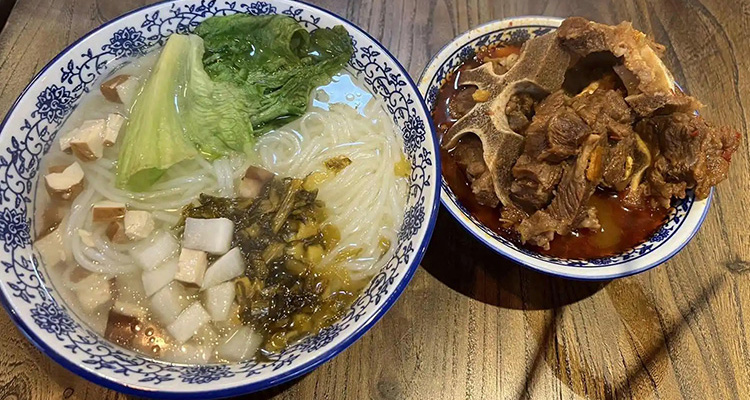Jingdezhen Beef Bone Noodles – Spicy Jiangxi Street Food & Traditional Noodle Soup
When a steaming bowl of rice noodles topped with large beef bones arrives, the bright red broth glistens with spicy oil, and the aroma of beef mixes with the fresh scent of rice noodles—this is Beef Bone Noodles, a hearty dish that makes you want to dig in immediately! First, hold the beef bone and savor the chewy meat; then slurp the noodles soaked in the rich broth, letting the spicy heat travel from your tongue to your heart. Every bite is exhilarating.
1. Origin and History
Beef Bone Noodles originated in Jingdezhen, created by local ceramic artisans. After long hours of labor, workers needed a filling and nourishing meal. They combined beef bones with locally made rice noodles, inventing this affordable yet hearty dish. Today, it’s a signature Jingdezhen snack, perfectly blending the city’s ceramic and culinary heritage.
2. Cultural Significance
In Jingdezhen, beef bone noodles provide genuine comfort for workers. In the morning, ceramic artisans start their day with a steaming bowl; at night, it soothes tired bodies. This dish reflects the enduring traditions of the “Porcelain Capital” and embodies the practical wisdom of the laboring people.

3. Key Ingredients
Only meaty beef spinal bones are used, simmered for hours yet retaining a chewy texture. The rice noodles are late-harvest Jingdezhen rice noodles, smooth and resilient. The broth is prepared by boiling beef bones for several hours with over twenty spices, and finished with specially made chili oil for a perfectly spicy kick.
4. Cooking Process
First, blanch the beef bones and simmer them in a large pot with a spice bag for three hours. Separately, cook the rice noodles and place them in a bowl. Pour the boiling beef bone broth over the noodles, add the stewed beef bones, drizzle with chili oil, and sprinkle with fresh cilantro. A steaming bowl of beef bone noodles is ready to serve.

5. Flavor and Texture
The meat on the beef bones is chewy and flavorful, the rice noodles absorb the rich broth, and the soup is spicy yet aromatic. The balance of heat, richness, and umami makes every bite intensely satisfying. It’s spicy but not overwhelming, fragrant but never greasy.
6. How to Eat
The most authentic way is to hold the beef bone in your hand and bite off the meat. Then enjoy the noodles and finally drink the remaining broth. Locals may pair it with pickled vegetables to balance the spice or a chilled beer for a more indulgent experience.

7. Tasting Recommendations
Try it at “Sister Tao Beef Bone Noodles” (approx. ¥25–40 per person) or “Maozi Specialty Snacks” (approx. ¥20–35 per person) in Jingdezhen. The best time is during late-night hours. You can order by saying, “I’d like a large bowl of beef bone noodles with extra spice.”
8. Tourist Tips
The English name is “Jingdezhen Beef Bone Noodles.” Wear a bib or napkin to avoid spills, and request mild spice if you prefer. After eating, don’t forget to wash your hands—the most authentic way to enjoy this street-style dish.
9. Simple Home Version
At home, use beef brisket instead of beef bones and a pressure cooker to shorten cooking time. Soak dried rice noodles for the noodles and make your own chili oil. While it won’t perfectly replicate the restaurant’s secret recipe, you can still enjoy a delicious version at home.
Come to Jingdezhen and let this steaming, spicy bowl of Beef Bone Noodles ignite your taste buds! When the rich, spicy broth bursts in your mouth and the beef flavor lingers on your palate, you’ll understand why this hearty street food is a favorite among locals. In the “Porcelain Capital,” Beef Bone Noodles offer a taste of authentic, down-to-earth Jingdezhen culture.


